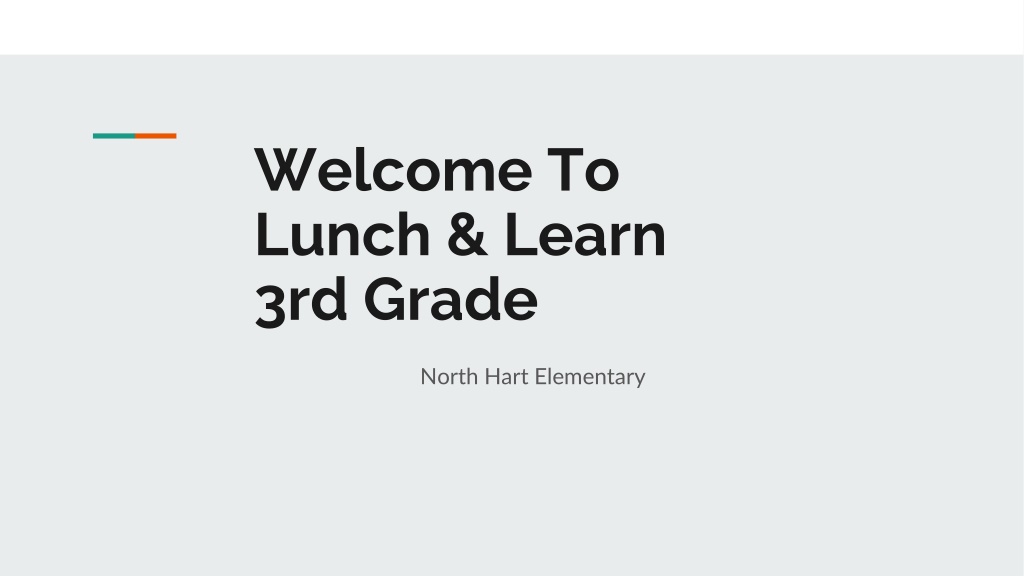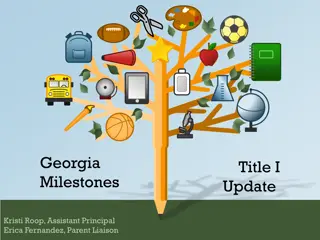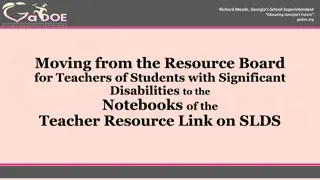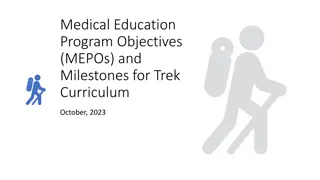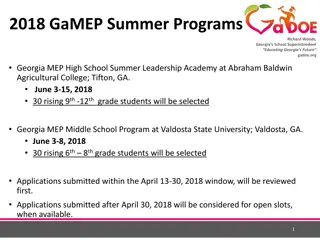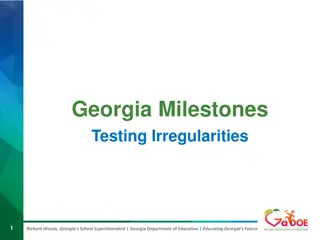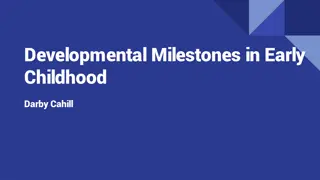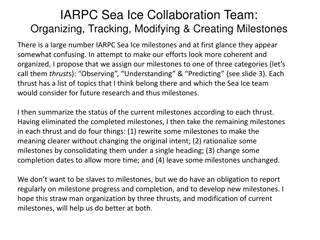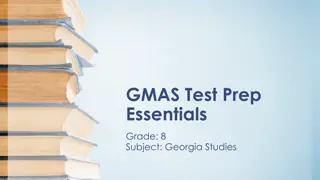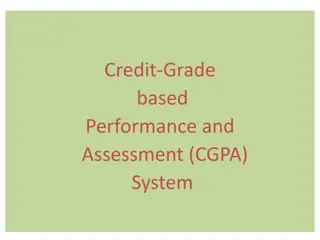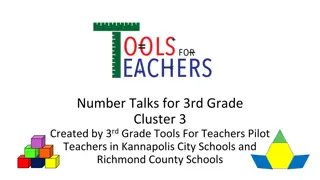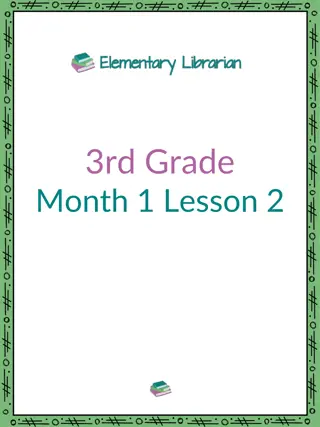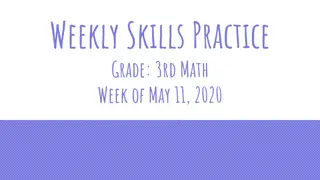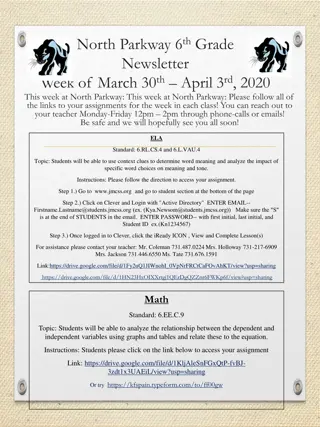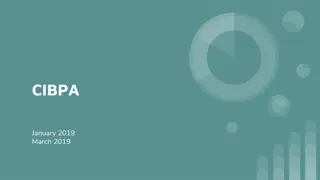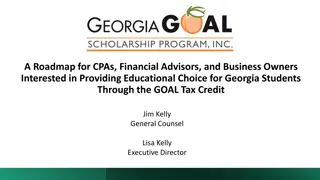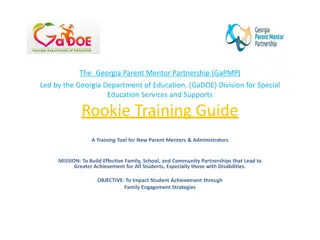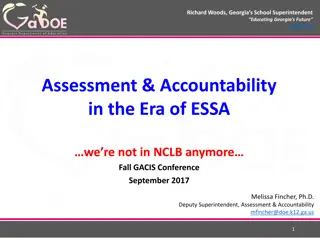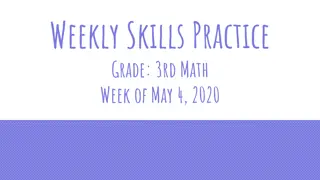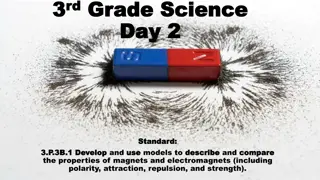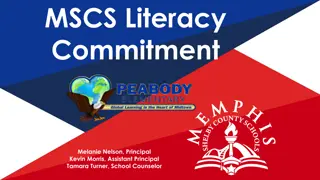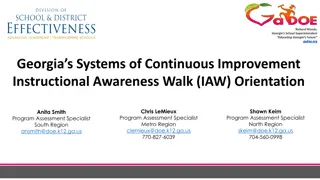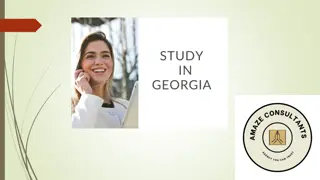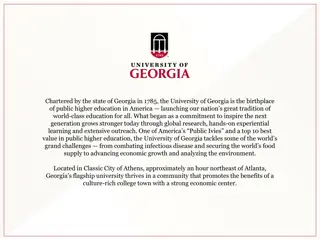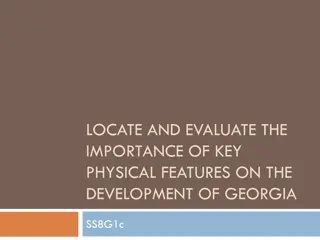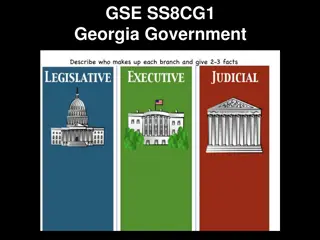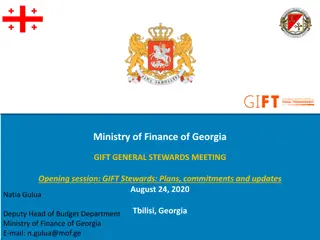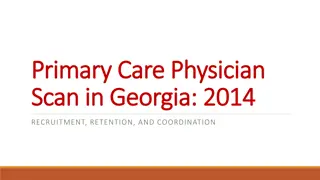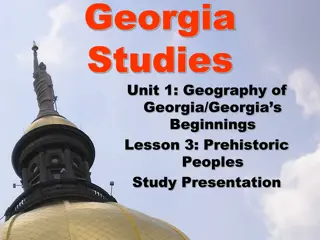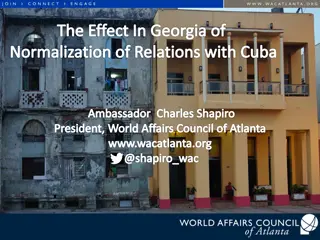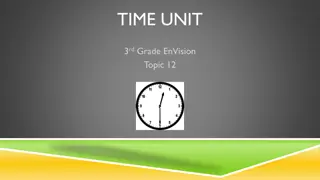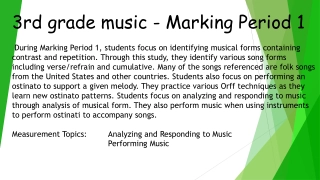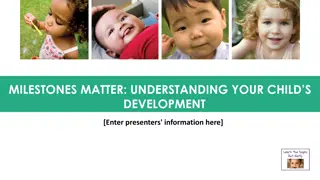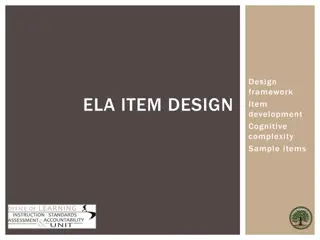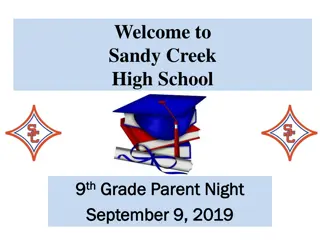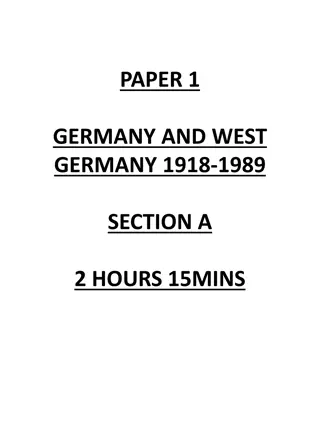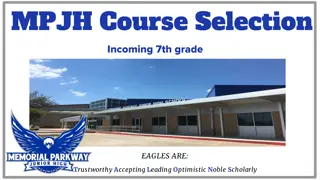Georgia Milestones Assessment Overview for 3rd Grade Students
Learn about the Georgia Milestones assessment for 3rd grade students at North Hart Elementary. The assessment includes English Language Arts and Mathematics tests with specific item types and time limits. Practice tests and Depth of Knowledge levels are also discussed to help students prepare effectively.
Download Presentation

Please find below an Image/Link to download the presentation.
The content on the website is provided AS IS for your information and personal use only. It may not be sold, licensed, or shared on other websites without obtaining consent from the author. Download presentation by click this link. If you encounter any issues during the download, it is possible that the publisher has removed the file from their server.
E N D
Presentation Transcript
Welcome To Lunch & Learn 3rd Grade North Hart Elementary
Georgia Milestones Formally known as CRCT Computer Based Written Response/Typing Consistent expectations and rigor to position Georgia students to compete with peers nationally and internationally. Georgia Milestones Parent Resources shorturl.at/DMTY3 http://www.gadoe.org/Curriculum-Instruction- and-Assessment/Assessment/Pages/Georgia- Milestones-Assessment-System.aspx
How The Test Is Formatted DESCRIPTION OF TEST FORMAT AND ORGANIZATION The Grade 3 English Language Arts (ELA) EOG assessment has a total of 60 items. You will answer a variety of item types on the test. Some of the items are selected-response (multiple-choice), which means you choose the correct answer from four choices. Some items will ask you to write your response using details from the text. There will also be a writing prompt that will ask you to write an essay. The test will be given in three sections. (April 27 - 29) Section 1 will be given on Day 1. You will be given a maximum of 90 minutes to complete the section.* Sections 2 and 3 will be given over one or two days. You may have up to 75 minutes to complete each section. DESCRIPTION OF TEST FORMAT AND ORGANIZATION The Grade 3 Mathematics EOG assessment consists of a total of 73 items. You will answer a variety of item types on the test. Some of the items are selected-response (multiple-choice), which means you choose the correct answer from four choices. Some items will ask you to write your response. The test will be given in two sections. (May 4-5) You may have up to 85 minutes per section to complete Sections 1 and 2. The test will take about 120 to 170 minutes.
Practice Test Log Into the Practice test on the Chromebook. Go to: http://www.gaexperienceonline.com/ This is the format students will see on the Milestones test. Go through the test and ask any questions you have. Username: Georgia35 Password: Training
DEPTH OF KNOWLEDGE Level 1 (Recall of Information) Identify, list, or define something. Questions may start with who, what, when, and where. Recall facts, terms, or identify information. Level 3 (Complex Reasoning) Go beyond explaining or describing how and why. Explain or justify your answers. Give reasons and evidence for your response. Make connections and explain a concept or a big idea. Level 2 (Basic Reasoning) Think about things it is more than just remembering something. Describe or explain something. Answer the questions Level 4 (Extended Reasoning) Complex thinking required! Plan, investigate, or apply a deeper understanding. These items will take more time to write. Connect and relate ideas. Show evidence by doing a task, creating a product, or writing a response.
DOK 1-ELA Example Ashley plays basketball well, but Tina is ______? Which word BEST completes the sentence? A. gooder B. more good C. better D. best
DOK 2-ELA Example Read the article Island Giants and answer example items 2 and 3 Island Giants At one time, every continent in the world had giant tortoises. A tortoise is like a turtle, but tortoises live only on land. For many reasons, giant tortoises can now be found only on a few islands. Most of the giant tortoises live on the Gala pagos [ga-LA-puh-gus] Islands in the Pacific Ocean. Their numbers have been going down for hundreds of years. But now people are helping them to return. The Gala pagos Islands were named after the many giant Gala pagos tortoises that live there. A Gala pagos tortoise can grow to be five feet long. It can weigh up to 500 pounds. There are 12 different kinds of these giant animals. The biggest difference is in the shape of their shells. They can have a high, round shell. The shell can also be flatter. Every island in the Gala pagos Islands has its own kind of tortoise. Many of the Gala pagos tortoise s problems started with people. Gala pagos tortoises like to eat grass. Hundreds of years ago, people brought goats to the Gala pagos Islands. The goats ate up so much grass that there was nothing for the tortoises to eat. Also, sailors took the tortoises onto their ships and used them for food. Around 40 years ago, some people who wanted to help the tortoises took the goats away from the islands. They also brought more tortoises back onto the islands. There are now more Gala pagos tortoises than there were 40 years ago. Let s hope the number of these amazing animals continues to grow!
DOK 2- ELA Example Which paragraph BEST explains why the number of Gala pagos tortoises went down? A paragraph 1 B paragraph 2 C paragraph 3 D paragraph 4
DOK 3-ELA Example What is the main idea of the passage? Use details from the passage in your answer Write your answer on the lines provided Points awarded Sample Response Points Awarded The main idea of the passage is that Gala pagos tortoises were in trouble, but now they are coming back. The author says that people brought goats to the island, and sailors used tortoises for food. But people also helped the tortoises to come back by taking the goats away. Now there are more than there were 40 years ago. 2 The main idea of the passage is that Gala pagos tortoises were in danger, but things are better now for them. 1 0 The passage is about large tortoises that live on an island.
DOK 4- ELA Example In this section, you will read two passages about skates How are roller skates and in-line skates different? You will write an informational piece explaining the ways in which roller skates like Amy s grandmother s skates were different from in-line skates Before you begin planning and writing, read these two passages: 1 The History of Roller Skates 2 The Skates in the Closet
Example of a Seven-Point Response: There are many differences between older roller skates and in-line skates. For one thing, the wheels are in different places. Older roller skates had two wheels on the front and two near the heel. The wheels on in-line skates have all the wheels lined up in a row. Their wheels are made of different kinds of materials. Amy s grandmother s skates had metal wheels. Roller skate wheels could also be made of wood or plastic. On the other hand, in-line skates all have soft plastic wheels. That is why in-line skates aren t as bumpy as roller skates. They also aren t as loud. With the older roller skates, it was harder to turn and harder to stop.
How essays are graded! Writing Trait Points Criteria Writing Trait Points Criteria The student s response is a well-developed informative/explanatory text that examines a topic in depth and conveys ideas and information clearly based on text as a stimulus. Effectively introduces a topic Groupsrelatedideastogethertogivesomeorganizationtothewriting Effectivelydevelopsthetopicwithmultiplefacts,definitions,anddetails Effectively uses linking words and phrases to connect ideas within categories of information Provides a strong concluding statement or section The student s response demonstrates full command of language usage and conventions. Has clear and complete sentence structure, with appropriate range and variety Shows knowledge of language and its conventions when writing Any errors in usage and conventions do not interfere with meaning* 4 3 The student s response is a complete informative/explanatory text that examines a topic and presents information based on a text as a stimulus. Introduces a topic Develops the topic with some facts, definitions, and details Groups some related ideas together to give partial organization to the writing Uses some linking words to connect ideas within categories of information, but relationships may not always be clear Provides a concluding statement or section 3 The student s response demonstrates partial command of language usage and conventions. Has complete sentences, with some variety Shows some knowledge of language and its conventions when writing Has minor errors in usage and conventions with no significant effect on meaning* Idea Development, Organization, and Coherence This trait examines the writer s ability to effectively establish a controlling idea and to support the idea with evidence from the text(s) read and to elaborate on the idea with examples, illustrations, facts, and other details in order. The writer must integrate the information from the text(s) into his/her own words and arrange the ideas and supporting evidence (from text that they have read) in order to create cohesion for an informative/ explanatory essay. Language Usage and Conventions This trait examines the writer s ability to demonstrate control of sentence formation, usage, and mechanics as embodied in the grade- level expectations of the language standards. 2 The student s response is an incomplete or oversimplified informative/ explanatory text that cursorily examines a topic based on a text as a stimulus. Attempts to introduce a topic Attemptstodevelopatopicwithtoofewdetails,butnotalloftheseare supported or relevant to the topic Ineffectively groups some related ideas together Uses few linking words to connect ideas, but not all ideas are well connected to the topic Provides a weak concluding statement or section 2 The student s response demonstrates weak command of language usage and conventions. Has fragments, run-ons, and/or other sentence structure errors Shows little knowledge of language and its conventions when writing Has frequent errors in usage and conventions that interfere with meaning* 1 The student s response is a weak attempt to write an informative/ explanatory text that examines a topic based on a text as a stimulus. May not introduce a topic or topic is unclear May not develop a topic May be too brief to group any related ideas together May not use any linking words to connect ideas Provides a minimal or no concluding statement or section 1 The student s response is flawed for various reasons and will receive a condition code: The condition codes can be found on page 131 of this guide. 0 The student s response is flawed for various reasons and will receive a condition code: The condition codes can be found on page 131 of this guide. 0
DOK 1-Math Example Which of these is the BEST estimate for the mass of a feather? A 1 gram B 100 grams C 1 kilogram D 10 kilograms
DOK 2-Math Example Part A: Solve 60 7 = Part B: Explain each step you used to solve the problem Example of Correct Answer: The answer is 420. Another way to look at this is as repeated addition using multiples of ten. Seven groups of 6 tens is the same as 60 + 60 + 60 + 60 + 60 + 60 + 60, or 420. OR, this is the same as 6 7 10, which is 42 10 or 420.
DOK 3-Math Example This number sentence represents a word problem 32 = 8 Part A: Use the number sentence to write a story word problem Part B: Solve the problem Solution: __________________ Part C: Using the 32 dots shown, draw a circle around groups of dots to match your story problem Part D: Rewrite the number sentence 32 Solution: = 8 using multiplication and your solution from Part B
Curriculum/Standards For the remaining of the year the following standards will be covered: ELA We will be doing another book club-Non-fiction RI 1-9 will be reviewed Poetry Writing-Fairy Tale Writing and Constructive Responses Math Fractions, Measurement, Geometry Science Rocks, Soil, Fossils, and Pollution Social Studies Colonies, Government, and Economics
Standards Based Report Cards Progress Reports will be given out every 4 1/2 weeks. Report card grades are given in Social Studies and Science every nine weeks. Check Infinite Campus through parent portal.
www.studyisland.com Custom MAP Path NewsELA www.reflexmath.com www.ixl.com
